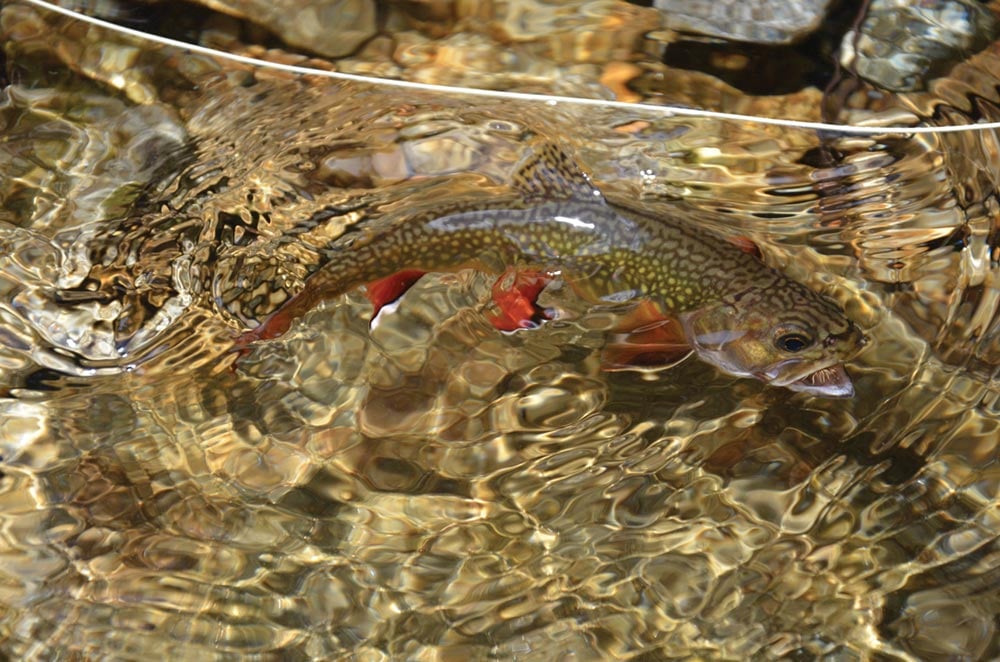Southern Appalachia’s native brook trout are often called the most exquisite fish on the planet. Soft in the hand, they are delicate and beautiful, especially in autumn when they’re painted for the fall spawn in deep purples and greens, with white-tipped fins and a pumpkin-orange belly.
And beauty must be a primary draw for anglers, because these little guys rarely grow longer than 10 inches. There is beauty of the fish as well as beauty in the high-mountain creeks where they live.
As char, more closely related to arctic char than rainbow or brown trout, brookies are the Southeast’s only native salmonid. They require clean cold water, and over the last century have been relegated to the region’s highest, most remote headwater streams, where they live short lifespans in gorgeous but nutrient-poor habitat.
In many cases, brook trout live where water seeps from the mountains and flows almost vertically through plunge pools and pocket water over a cobbled streambed. Each significant rain scours silt from these systems, leaving little to support insect life. In such conditions, there is not much for fish to eat, so they must feed aggressively and opportunistically.
These are perfect conditions for anglers who prefer simplicity. With a light rod, a good pair of wading boots, and a small box of dry flies, it’s a joy to climb a little mountain stream in search of native fish. Small streams might require creative casts, but brook trout are suckers for a well-placed and well-presented dry fly.
It’s a very good excuse to explore tumbling high-elevation rills. Catch the bug, and you’ll likely spend evenings studying maps to find the little blue lines where brook trout live.

The Backstory
Theoretically, brookies must have been larger and easier to find 18,000 years ago during the waning of the last ice age. Back then, they were anadromous and swam freely between the rivers and the oceans like coastal populations of Maine still do today.
Over thousands of years, a warming climate pushed brook trout on the southern end of the range into higher elevations and cooler waters. They were isolated to the hills by water conditions and evolved as genetically distinct pocket populations uniquely well suited to their habitats.
“They’re important ecologically,” said Jim Habera, a Tennessee-based fisheries biologist on the steering committee for the Eastern Brook Trout Joint Venture, which is a diverse organization of state and federal agencies and private entities dedicated to conservation of brook trout habitat.
“They’re oftentimes the only fish that occurs if you get high enough into the headwaters in our mountain streams. They’re the only fish that naturally occurs in a lot of those systems. So, it’s an important part of those stream ecosystems.”
Before the arrival of Europeans, brook trout were an important food source for Native Americans. Even after European settlement, brookies were valued for food as well as recreation. They were not, however, as monetarily valuable as the seemingly endless tracts of mountain timber. Large-scale timber operations ramped up across the Appalachians in the mid-1800s and continued almost unchecked for a century or more. Water conditions were dramatically altered in timbered drainages, and much brook trout habitat was lost.
The second big blow came in the early 1900s, when non-native brown trout from Europe and rainbow trout from the West were introduced to Appalachian streams. Both species are tolerant to a wider range of water conditions and grow larger than our little natives. They outcompeted brook trout for resources, and although there are numerous instances of natives and non-natives co-existing, the remaining strongholds for brookies in the South are at high elevations, where a barrier such as a waterfall blocks passage of rainbow and brown trout.
According to a 2018 report from the Joint Venture, eight percent of historic brook trout water remains intact in their native U.S. range from north Georgia to Maine. Continuing threats from development, land-use changes, destructive agricultural practices, warming water temperatures, and invasive species make preserving and expanding existing brook trout populations an ongoing fight.
In the Mid-Atlantic, especially in West Virginia, Virginia, and Maryland, altered water chemistry due to acid precipitation and mining is a major hurdle, combated with regular applications of limestone sand directly to streams to neutralize acidity.
State and federal agencies, as well as conservation organizations like Trout Unlimited, conduct habitat improvement across the region. Reclamation projects remove non-native species from streams, which are then repopulated with brook trout. Genetics plays a major role in this process. The goal is to reintroduce fish from a source population that’s genetically as close as possible to what would have originally existed.
Years ago, genetics showed southern Appalachian brook trout are a distinct and separate strain of fish from northern brook trout, which inhabit the northeastern U.S. and Canada. Recent and ongoing studies have shown these genetic differences can be broken down even further.
“Right now population geneticists recognize six different clades, or related groups of brook trout,” said Habera.
For the most part, they look and act the same, but they evolved in isolation and descend from separate ancestry. For the sake of simplicity on a very complicated and evolving subject, southern brook trout only inhabit the mountains of Georgia, South Carolina, Tennessee, North Carolina, and Virginia. In some regions, locals call these fish “specks.”
Fishing and even angler harvest are not major concerns to brook trout populations on most streams. According to the National Park Service, brookies in stream habitats reach reproductive maturity at two years of age, and their average lifespan is about three years. If a fish is large enough to catch and keep, it has already had the opportunity to spawn and is not likely to live much longer.
“Angler harvest is very insignificant at this point,” said Habera. “The type of anglers willing to seek out brook trout and catch them generally aren’t interested in harvesting them, anyway.”
One of Joint Venture’s goals is to increase recreational fishing opportunities for wild brook trout, which in turn promotes conservation of the species. On that note, here are a handful of places to begin your search for southern Appalachian brook trout.
Georgia
On the very southern edge of the brook trout’s range, the north Georgia mountains are a place where specks truly are isolated to tiny high-elevation trickles. Revealing the names and locations of these headwater streams is often frowned upon, and most of them aren’t named on most maps, anyway.
If you’re willing to do the research and burn the boot leather, Cherokee National Forest is where you should go. This patchy swath of public land stretches across most of the northern end of the state, so it’s a lot of territory to cover. Small pockets of brookies exist from the Cohutta Mountains over to South Carolina, and surveys indicate less than 40 miles of stream contain natives.
Here are some hints to help narrow your search. Strap on your boots and seek out small tributaries of the Conasauga River system around Cohutta Wildlife Management Area. Look to the very beginnings of the Chattahoochee River. Check out Blue Ridge Wildlife Management Area and climb up into the highest headwaters of the Toccoa river. Or, head east over to the Chattooga River drainage and explore little tributaries no one else would think to fish.
South Carolina
South Carolina anglers also hold the locations of brookie streams tightly to their chests. Most of South Carolina’s trout water is isolated to the mountains of the Upstate. That’s also where you’ll find the brook trout in high headwater streams of Oconee, Pickens, and Greenville counties.
Some of the Saluda River sub-tributaries on Mountain Bridge Wilderness Area are known to protect populations of native brookies. Specks also live in several very small creeks that eventually feed into the South Carolina side of the Chattooga River. Reintroduction projects as well as some existing pockets of natives exist on the 50,000 protected acres of forest at Jocassee Gorges.

Tennessee
With more and larger waters harboring specks, as well as extensive reintroductions, it’s possible to be more informative about brook trout streams the farther north you go. In Tennessee, both the Tennessee Wildlife Resources Agency and Great Smoky Mountains National Park actively promote their brook trout fisheries.
Tennessee’s best brook trout fisheries are in the northeastern corner of the state. “Carter County and Johnson County are kind of the epicenter of brook trout fishing in Tennessee,” said Habera.
The Left Prong of Hampton Creek, on Hampton Creek Cove State Natural Area near Roan Mountain, might be the best brook trout stream in the state. Gentry Creek and several other northwest flowing tributaries to Beaverdam Creek in Johnson County also have strong fisheries.
And those streams are just a start. There are more than 100 east Tennessee streams that harbor wild populations of brook trout. And in the Smokies, Lynn Camp Prong is one of the best and most beautiful speck streams in the park.
North Carolina
Western North Carolina has the highest peaks in the Appalachians. It also has some of the best speck water in the country. Head high enough into pretty much any drainage in the mountains, and you’ll likely find some specks.
If you like to venture into remote areas, check out the headwaters of Raven Fork in Great Smoky Mountains National Park. The hike into the fishery is difficult, and the river gorge is very rugged with large plunge pools and larger-than-average brookies.
For a little easier access, head over to Shining Rock Wilderness and the East Fork of the Pigeon River. With a short hike, the East Fork itself is big speck water. Several of its tributaries are also worth exploring.
Big Snowbird Creek in Graham County is another very good option. Drive to the end of the road, gear up, and hike in about three miles to Lower Falls. You’ll start encountering natives and some very pretty water upstream of this point.
Virginia
Virginia claims to have more native brook trout water than any other state in the Southeast. With more than 2,000 miles of documented brookie streams, that’s probably true. Most of those miles are populated with northern strain brookies, which are still beautiful natives; they’re just of a different lineage than southern Appalachian brook trout.
Virginia’s best brook trout waters fall from the mountains on either side of the Shenandoah Valley. In Shenandoah National Park, the upper ends of rivers and creeks like the Rapidan, Rose, and North Fork of the Moormans are all excellent brook trout fisheries. Over on the other side of the valley, Dry River in the George Washington National Forest boasts the highest population density of brook trout in the state. If there is a catch, it’s that all these streams are home to northern brook trout. To find southern-strain fish, you have to fish from the New River drainage south.
Little Stony Creek in Giles County is well known for its giant cascades. It offers a mixed population of rainbows and native southern brookies that trends more toward brook trout the farther you’re willing to hike. Farther south, Crooked Creek Fish Management Area in Carroll County is a fee-fishing area with a roughly three-mile stretch of water protected for native brook trout.
Nick Carter is the author of “Flyfisher’s Guide to North Carolina & Georgia.” The guide is available on Amazon.com, and autographed copies are available by emailing the author at [email protected].
Cover photo by Nick Carter








